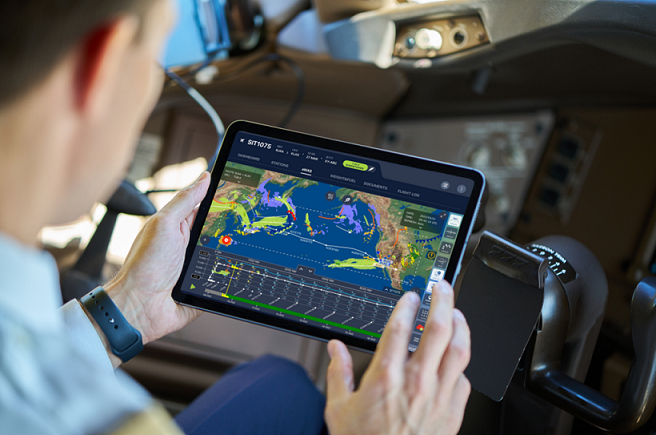Data-Driven, Collaborative And Integrated Apps To Drive Efficiency

Today, more than ever, flight operations staff – pilots in particular – face multiple challenges. Ensuring safe and punctual operations while making flights sustainable and the journey comfortable for passengers is paramount to emerging in a competitive industry.
New technologies provided by SITA enable, for instance, to save 5% of climb-out fuel, reduce aircraft exposure to severe turbulence by 85%, and save hundreds of thousands of US dollars in maintenance costs related to weather events.
That’s why today, more than 50,000 pilots and dispatchers in more than 60 airlines worldwide rely on SITA’s apps to make flights more efficient and sustainable.
Global warming impact on aviation
Global warming is already strongly affecting airline flight operations. Delays and disruptions caused by weather conditions account for 75% of air traffic delays in the US, costing airlines billions of dollars each year in extra fuel, maintenance, crew, and compensation expenses.
In particular, clear-air turbulence has increased in various regions worldwide due to a warming climate. Clear-air turbulence is hazardous to aircraft and challenging to observe before an aircraft's track, making it both "dangerous and expensive." As extreme weather events like clear air turbulence become more frequent and intense globally because of a warming climate, airports, aircraft, and flight operations are increasingly vulnerable. It thus is essential for pilots to be able to have the best weather situation awareness when preparing their flights.
The weather awareness application SITA eWAS is their best ally to plan, anticipate, and adapt. Using SITA eWAS pilots relies on a best-in-class application that provides comprehensive worldwide weather forecasts and observations, building on multiple weather sources. That dynamic information is then displayed intuitively on a moving map pilots can use on the ground to prepare their flights or during the flight to make any decision to adapt their track to adverse weather conditions.
With SITA eWAS, pilots can better brief the crew, are more comfortable decreasing the amount of discretionary fuel loaded onboard (up to 10% in a major European airline) and are better supported in their decision-making.
Airlines towards more sustainable operations
When it comes to more sustainable flight operations, pilots are on the front line. They have to plan their flights efficiently – with the support of the dispatch team – to reduce flights’ carbon footprint. On top, they have to deal with numerous fuel-saving initiatives deployed by airlines to cut fuel costs and carbon emissions.
To minimize the impact on pilots' workload, it is essential that all those initiatives are seamlessly and intuitively integrated into the pilot workflow. This will significantly contribute to their adoption and application, driving more efficient and sustainable flights.
To cut fuel burn and reduce carbon footprint, SITA offers airlines a unique data-driven solution called SITA OptiFlight®. This solution builds tail-specific, predictive performance models using flight data and machine learning combined with 4D weather forecast to determine the most fuel-saving scenarios for all phases of a flight.
SITA OptiFlight's fuel-saving scenarios are then translated into easy-to-apply inflight tactical recommendations and seamlessly delivered to a pilot's existing Electronic Flight Bag app, such as SITA eWAS or SITA Flight Folder.
For example, using SITA OptiFlight® to optimize the climb phase, our customers save an average of 80+ tons of fuel and cut carbon emissions by 250+ tons per year per jet aircraft with an application rate of more than 75%.
Cockpit "smart" digitalization, a key driver to efficiency
Many airlines stick to legacy documentation and logging to prevent changes to working processes. But the result of overlooking intuitive, digital alternatives is wasted time, money, and resources.
However, airlines seeking to go digital have to pay attention not to overload pilots. Indeed, the main risk is to see pilots juggle information across various applications. Managing siloed flight data in this way is confusing, time-consuming, and will lead to inefficiencies. Ensuring a smooth pattern for pilots with all the information they need at the right place and time is essential when going digital. Otherwise, the overwhelming environment created will destroy the benefits brought by the digital world.
Recognizing the need for a streamlined solution, SITA’s electronic Flight Folder (eFF) known as SITA Flight Folder offers, on top of its user-friendly and comprehensive interface, a seamless integration with other EFB applications meaning that pilots have access to invaluable tools to enhance the efficiency and sustainability of their flights all on one single dashboard.
SITA Flight Folder natively embeds the SITA eWAS application and SITA OptiFlight® recommendations to ensure seamless, ergonomic integration in the pilot flight briefing and flight management. Pilots thus get the right information at the right time in one single interface to keep the impact on workload to a minimum and help them make the right decisions.
Do you want to equip your pilots for efficient flight briefings, enhanced decision-making, and reduced flight carbon footprint today?
Contact us at: https://www.sita.aero/the-most-efficient-flight/start-your-journey/